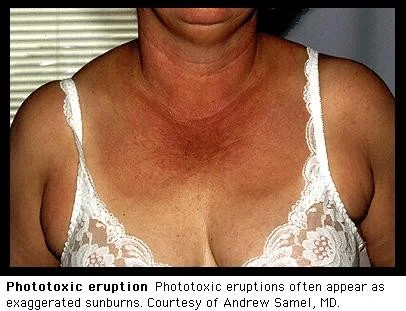Photosensitivity
Types and Mechanisms
-
Two types include phototoxic eruptions and photoallergic eruptions.
-
Phototoxic eruptions are due to absorption of UV light (usually UVA) by the drug, which causes a release of energy and damage to cells. Looks like a bad sunburn, which may blister.
-
Photoallergic eruptions are a lymphocyte-mediated reaction caused by exposure to UVA, which converts the drug to an immunologically active compound that activates lymphocytes, causing an eczematous reaction in a photodistribution.
-
Both types can be caused by phenothiazines, chlorpromazine, sulfa, and NSAIDS, although phototoxic reactions are more common with these agents.
Phototoxic eruption Phototoxic eruptions often appear as exaggerated sunburns.
